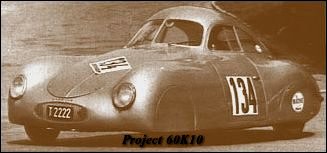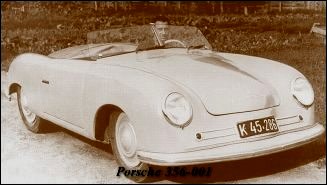|
On
25 april 1931 Professor Ferdinand Porsche founded his automotive
engineering company. The company was named: |

|
| Ferdinand Porsches big dream was to build sportscars carrying his own name... In the year 1936 he started project 60K10, a racingcar prototype to participate in the Berlin-Rome road race. The 60K10 was mechanically based on "KDF-Wagen" components of which the chassis, engine and other components were used. In 1939 project 60K10 was finished; a beautiful aluminium bodied aerodynamic racingcar was the result. Regretfully the second world war became reality and all projects at Porsche were stopped and the Berlin-Rome road race was cancelled. Porsche moved his company and the production line to an old sawmill in Gmünd, Austria. |

|
|
After the
second world war not much was left of the German industry, everything
needed to be rebuilt. The old Porsche company building in Stuttgart
Germany was taken by the allies, the personnel had to manufacture gardening
equipment and repair farming machinery. In the old sawmill in Gmünd Ferdinand Porsches son Ferry Porsche and Prof. Eberan van Eberhorst started working on project 356 in the year 1947. On that moment in time Ferdinand Porsche was still imprisoned in France being suspected of war crimes. Ferdinand Porsche was found not guilty and was set free in August 1947. He joined project 356 and the first prototype was finished in march 1948; Porsche 356-001 was born. The Porsche 356-001 was built using a chassis with tubular framework covered with aluminium body panels. Mechanically the car was based on Volkswagen components. The Porsche 356-001 was equipped with a center mounted engine located just in front of the rear axle. |

|
|
The Porsche 356-001
prototype was evaluated and some changes were made for the production
model. The most evident change was the relocation of the engine which
would move behind the rear axle to provide additional interior space. The production Porsche 356 shape was designed by Erwin Komenda. Until 1948 approximately 50 Porsche 356 cars were built with aluminium bodies in the old Gmünd sawmill, these cars are currently known by the name "Gmünd models". Porsche never planned large scale production of the 356 but the production facility in Gmünd soon became insufficient. In the year 1948 Porsche moved back to Stuttgart Germany. They rented a facility next-door the old Porsche building and they rented additional space at bodywork factory Reutter. The Reutter firm was asked to built the Porsche 356 coupe body's and manufacturer Gläser became responsible for the production of the 356 convertible body's. All 356 bodywork variant were now built of steel. Spring 1949 the Porsche 356 appeared at it's first car show; the Geneva car show. The Porsche 356 was going to have a long production life in which it was improved continuously. Between 1948 and 1963 the following 356 models were presented; Gmünd
models 1948 - 1951, the pre-A models 1950 - 1955, the 356 A 1955 -
1959, the 356 B 1959 - 1963, |

|
|
September
1963 saw the introduction of the Porsche 356 successor on the
Frankfurter car show; the Porsche
901 (later to be known as Porsche 911). In the month October of the year 1964 the Porsche 901 was renamed (re numbered) 911. Porsche was forced to do so because automobile manufacturer Peugeot owned the legal rights on three digit car numbers with the "0" in the middle. As often happens with the introduction of a new model the existing Porsche customers were not very charmed by the new model. They claimed the 901/911 was too large, too powerful and to luxurious to be a real Porsche... |

|
|
The market
proved the opposite for Porsche. The Porsche 911 sold and sells very
well and would prove to be timeless by design. The basic 911 concept and
dimensions evaluated over the years and the car became fully
thoroughbred. The first extensive redesign (without change of concept and basic shape) would be materialized in the Porsche 911/993 which was presented in the year 1993... The Porsche 911 was designed with a steel unitary bodywork construction in which the engine was located behind the rear axle. The 911 engine is a air-cooled six cylinder "boxer" engine. The suspension of the Porsche 911 was independent from the start as was a five speed gearbox with floor shift. The
air-cooled Porsche 911 six cylinder boxer engine would evaluate enormous
through the 35 years of production; it grew from 2 liter
capacity up to 3.6 liter... The six cylinder boxer engine is still built
but was converted to liquid cooling to keep up with sound- and emission
control standards. The liquid cooled six cylinder boxer engine was
presented in the 911/996 model which was introduced in the year
1998. The 2-liter 911 1963 - 1969, the 2.2-liter 911 1970 - 1971, the 2.4-liter 911 1972 - 1973, the 2.7-liter 911 1974 - 1977, the 911 Turbo 1975 - 1993, the 911 SC 1978 - 1983, the 911 Carrera 3.2 1984 - 1989, the 911/964 Carrera 4 and 2 1989 - 1993, the 911/993 Carrera 1993 - 1998, the 911/996 Carrera (liquid cooled) 1997 - present day. In the many years of Porsche 356 and 911 production Porsche also designed many successful racing cars such as the 1958 Porsche 718 RSK Spyder. (Click here tot take a look at, amongst others, 6 championship winning Porsche GT sports cars). |

|
|
Porsche
also designed and built sportscars for street use fitted with centrally
mounted engines and front mounted engines. In the year 1969 the result of a project in cooperation with Volkswagen was the VW-Porsche 914. This car was fitted with a centrally mounted VW four cylinder engine. Also a limited series was built with the two liter Porsche flat six engine; this car was named Porsche 914-6. The VW-Porsche 914 was a huge success, over 100.000 were sold... |

|
|
In the year 1975
Porsche introduced the Porsche 924 which was developed in cooperation
with Volkswagen again. The 924 was designed by the Dutchman Harm Lagaay
who is responsible for the looks of every Porsche model ever since. The
Porsche 924 was a good looking car and it was fitted with a two liter
Audi four cylinder engine. Again the cooperation with Volkswagen proved
to be successful; over 110.000 Porsche 924 cars were sold until 1985. In the year 1977 a revolution takes place at Porsche as they introduce the very futuristic Porsche 928. The 928 was fitted with a new Porsche engine design, a 4.5 liter V8 engine which was front mounted powering the rear wheels of the car. The Porsche 928 was a real GT sportscar for long distance drives, with it's perfect suspension and powerful engine it was able to perform extraordinary with great driving comfort. The Porsche 928 was going to win the "Car of the year" award in 1978 which was a surprise because it was a very expensive top-of-the-line sportscar... Porsche was able to attract a new customer group with the 928. After 18.000 cars being produced Porsche ceased production of the 928 in the year 1982. |

|
|
The early
eighties of the twentieth century were highlights of Porsche production.
Porsche produced the 911, 928 and 924 and at the same time impressive
successes were achieved in the Group C racing competition. In 1983
Porsche was able to win the famous 24 hour race at Le Mans... In this time period the management team at Porsche was in crisis; they were focused on short term financial results and innovation and technical development was neglected. The arrival of Peter Schutz as head of the Porsche management in 1982 meant a revival. Technical innovation and long term thinking were adopted as key strategy items at Porsche. To show the technical and innovative capabilities at Porsche to the entire world the ultimate Super-Sportscar was created; the Porsche 959. The car had to be better than every sportscar ever built...Porsche succeeded. The Porsche 959 embodied all technical know how in use of materials, electronics and mechanics. This four wheel drive sportscar was modified for off road racing an was also able to win the desert race Paris-Dakar...easy... The Porsche models 924 and 928 were taken out of production and because of the large efforts being invested in project 959 the further development of the Porsche 911 was running behind. With the introduction of the Porsche 911 Carrera 3.2 in 1984 Porsche was back on track with top sales in 1985. Two years
later sales dropped again due to the customer perception that the
Porsche 911 was out of date... Click
here to view a selection of Porsche models in the
ClassicarImages archives. |
| Read more in the worlds most complete internet Porsche archives www.flat-6.net |